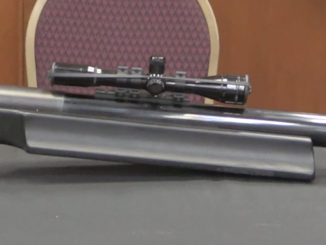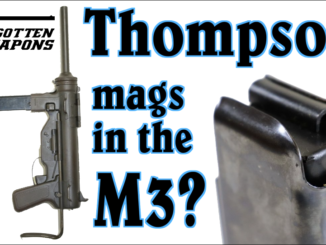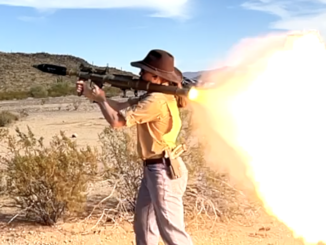The R75A was the last version of Colt’s commercial BAR, with 832 made between August and December of 1942 for the Netherlands Purchasing Commission. It was a derivative of the commercial R75 BAR, with a pistol grip, magazine well cover, and ejection port cover. The R75A added on a folding bipod and a detachable barrel functionality, albeit not of the most elegant sort. To remove the barrel, one first used the lever under the muzzle to detach the gas block from the barrel by sliding it rearwards. Then a tool or cartridge tip was used to pry open the barrel locking lever at the front of the receiver, which then allowed the barrel to be rotated about 60 degrees to unlock its interrupted threads and remove it.
© 2025 Forgotten Weapons.
Site developed by Cardinal Acres Web Development.




Seems that one cannot use the sling if the bipod is stowed.
Perhaps a redesign is needed. Ergonomic design to suit users was considered “artistic humbug” compared to having a successful functioning product overall until recently. Any objections?
“Ergonomic design to suit users was considered “artistic humbug” compared to having a successful functioning product overall until recently.”
Fact that ergonomics do not exist as separate area of knowledge, does not mean it did not exist at all.
Problem with BAR was that it was designed as, well, Automatic Rifle, not light machine gun, although there were several attempt to convert it to this role (including adding quick-change barrel) it can’t out-perform light machine guns designed for their role from start (like Madsen or Lewis)
I always thought the R80 Monitor (as well as a couple of the European variants like the FN Mle. D) looked like very decently ergonomic early LMGs. The biggest problems the American versions had were the enormous bipod and the strange dislike of pistol grips.
As Daweo said, the Browning M1918 was designed as a rifle and not a machine gun. Why the US Army refused the commercial upgrades of the BAR is beyond me, since it doesn’t make much difference in logistics to procure a stock with a pistol grip, a detachable muzzle brake, and a much better bipod that is attached to the gas tube or stock as opposed to the muzzle of the barrel!
Looking closely it appears the band that holds the sling swivel is free to rotate around the gas tube. Note the wear marks from the sling swivel rubbing on the tube. With the sling swivel band rotated to the right (away from the barrel change handle) I believe the sling could be utilized with the bipod stowed.
That sounds reasonable. I may sound stupid, but improving this particular gun is possible if one thinks of adding chrome lining to the barrel and gas cylinder, a good flash hider/compensator on the muzzle, and perhaps a low power scope to deal with pesky would-be snipers. But I have to wonder, where’s the cleaning kit?
So were these guns ever shipped to the Dutch? The Japanese had conquered the Dutch East Indies by March 42, leaving, as far as I am aware, just some small Dutch territories in South America. If they were shipped: how did this one manage to get back to the U.S.A? If they were not shipped what happened to them?
Most likely, no, for the reason you pointed out. Such weapons often ended up “sequestered” by the u.S. government and issued to “special services”, i.e. covert operations organizations with their own logistics trains, thus avoiding mixing them into the military’s TO&E.
Being in .30-06, it might have been used by any number of groups, ranging from Paramarines to the OSS. Its overall condition, though would tend to indicate it spent the war in an arsenal somewhere Stateside. 😉
cheers
eon
One of my Favorites!!
Excellent video, quite envious.
You seem to be getting a lot better shooting off-hand over the years. Almost every BAR variant covered! only a few remaining..
When I compare this Colt’s creation with vz.24 and 26 LMCs I see that the end result is about same, although with different ways how to get there. The barrel change for one: little fiddly on BAR and lot more simple on ZB, but there is price in increased complexity (and bulk) in form of added barrel nut. Actually, ZB could have kept that feature out; for LMG it would be acceptable even without it.
Interesting to see ‘most dressed up’ BAR in action.
“Colt’s creation with vz.24 and 26 LMCs I see that the end result is about same, although with different ways how to get there. ”
I can’t agree, this one has magazine sticking downward, when 26 has magazine sticking upwards. From technical point of view this might be tiny difference and more affecting magazine (spring acting together with gravity vs spring acting against gravity) but it terms of ergonomics it is great difference if weapon is to be used by 2-man crew (“proper” gunner and “magazine changer”)
Regarding ZB light-machine guns, they short later created what would be general purpose machine gun in modern terminology, namely ZB 50, see photos:
http://zonwar.ru/pulemet/Zbrojovka_Brno_ZB_vz50.html
it entered production in 1932, was belt-fed and could be fired from bipod or tripod. It is short-recoil/tilt. Some were exported in 1930s to Argentine.
You seem to be big follower of Czech guns; you actually know them better than me. Should I blame you for that? No way. 🙂
The bipod looks much more workmanlike and better in placement than the one on the M1918A2. Do we know why this type was not used on the latter weapon?
Polish rkm.wz.28 7.92 Mauser = colt Bar R75a mk.43 7.62
As far as the barrel release goes, operator testing should have revealed that problem and adding a projection for the thumb or forefinger to make the job easier and quicker is an obvious solution.
Oddly enough, my uncle Artie who served in the Northwest Europe campaign as an infantryman, remembered his unit having the number of BAR’s doubled after the Bulge from one to two per squad. He said they were strange as they had finned barrels and pistol grips. Were they R75a’s? Or did FN have a bunch of parts lying around that with sawing and filing could be adapted to 30-06? And who in the US Army would have paid them to do it? Uncle Art was the gun nut and hunter in the family (he taught me), so I think he would have noticed details like that. As he’s attended his last formation, I can’t ask him for further information, so it’s one of life’s little mysteries….